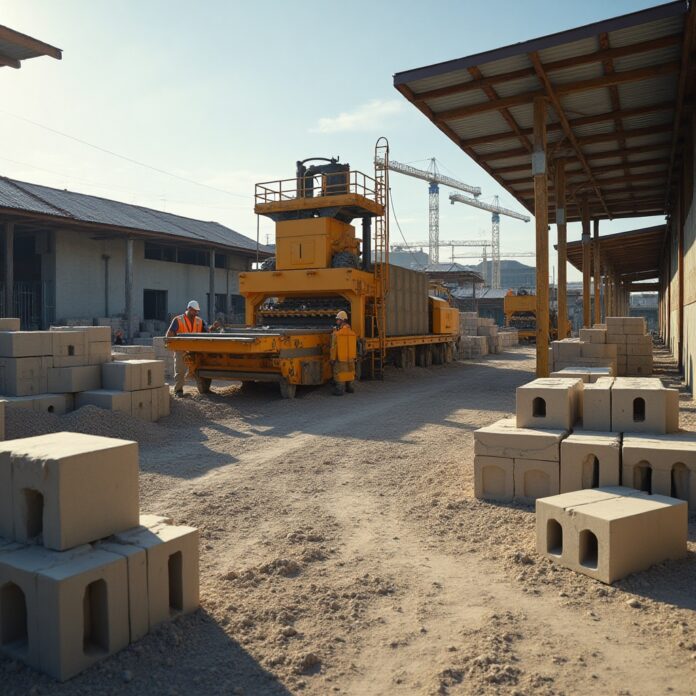Picture this: A world where cities rise from sustainable materials, and entrepreneurs like you are at the heart of this transformation. The global concrete block market is booming, projected to grow at a steady 6.12% annually through 2030, fueled by urbanization and eco-conscious construction trends. But here’s the catch—launching or scaling a cement block business isn’t just about mixing cement and sand. It’s a delicate dance of mastering material quality, outsmarting competitors, and riding the waves of seasonal demand. If you’re an entrepreneur eyeing this space, your success hinges on three pillars: sand quality, pricing agility, and seasonal adaptability. Let’s break these down, one game-changing strategy at a time.
Understanding the Cement Block Industry
Before diving into the nitty-gritty, let’s set the stage. Cement blocks are the unsung heroes of modern construction—durable, versatile, and increasingly green. The U.S. market alone is thriving, with revenue hitting $10.3 billion in 2025, thanks to infrastructure investments like the $1.2 trillion Infrastructure Investment and Jobs Act. Globally, Asia-Pacific leads the charge, driven by India’s $143 trillion infrastructure push and China’s urbanization boom. But it’s not all smooth sailing. Tariffs on steel imports, rising material costs, and cutthroat competition are squeezing margins. The key to standing out? Innovate relentlessly and lean into sustainability. Companies like CEMEX and UltraTech Cement are already setting benchmarks by blending recycled materials and automation. Your playbook? Learn from the giants but carve your niche.
Sand Quality: The Backbone of Block Durability
Let’s talk about sand—the silent star of your blocks. Poor-quality sand isn’t just a nuisance; it’s a profit killer. Imagine 15% of your raw materials turning into waste because of inconsistent grain size or organic impurities. To avoid this nightmare, start with rigorous testing:
- Sieve Analysis: Use ASTM C136 standards to ensure grains are neither too fine nor too coarse.
- Silt/Clay Tests: Follow ASTM D7928—anything above 5% silt weakens your blocks.
- Organic Content Checks: Decomposed plant matter? ASTM D2974 will flag it.
But testing alone isn’t enough. Where you source matters. Partner with certified suppliers of recycled sand—it’s 20% cheaper and slashes your carbon footprint. Local sand reduces transport costs, while mixing ratios (like 1:2:3 for cement-sand-aggregate) balance strength and cost. Take a cue from manufacturers in Nigeria and India, where split-faced blocks thrive because of optimized sand blends. Your mantra: Test, source smart, and mix like a pro.
Navigating Pricing Competition
Price wars are the quicksand of this industry. Underbidding rivals might win a contract today but erode profits tomorrow. Here’s how to stay competitive without racing to the bottom:
- Bulk Buying: Secure cement and sand at 15-20% discounts by negotiating long-term contracts.
- Automate Wisely: Vibrating machines boost output by 30%—invest in modular systems that scale with demand.
- Differentiate: Sell sustainability. Highlight recycled materials or energy-efficient curing to attract eco-conscious builders.
Look at industry leaders like SolidBuild Creations. They ditched generic blocks for custom designs—interlocking blocks for earthquake-prone areas, decorative facades for high-end projects. Another trick? Offer bundled services, like onsite block testing or delivery guarantees. Remember, competing on value beats competing on price every time.
Managing Seasonal Demand Fluctuations
Construction isn’t a year-round party. Monsoons halt curing in Asia; winter freezes demand in the Midwest. To survive the dips:
- Diversify Products: Pavers, AAC blocks, or garden edging can keep cash flowing in off-seasons.
- Stockpile Smartly: Buy raw materials cheaply during lulls—tariffs and inflation won’t catch you off-guard.
- Flex Labor: Hire temps during peaks; train them for quality control to avoid costly errors.
Financial cushioning is non-negotiable. Stash 10% of revenue for rainy days, and tap government grants for R&D—like developing frost-resistant blocks for colder markets. In India, manufacturers stockpile sand pre-monsoon; in the U.S., Midwest firms pivot to indoor projects during winter. Adaptability isn’t optional—it’s survival.
Sustainability as a Profit Driver
Green isn’t just a trend—it’s a goldmine. Recycled aggregates cut material costs by 15%, while IoT-powered curing slashes energy use by 20%. But sustainability isn’t just about savings; it’s a sales magnet. Target LEED-certified projects with thermal-efficient blocks, or partner with eco-conscious contractors for long-term deals. Take Bharathi Cement: Their green hollow blocks captured 15% market growth by aligning with India’s net-zero goals. Your roadmap? Certify your processes, track carbon savings, and shout about it in every proposal.
Case Studies & Success Stories
Let’s get inspired. SolidBuild Creations automated their curing process, trimming energy costs by 20% and landing a mega-contract with a green housing developer. Bharathi Cement bet on recycled fly ash, turning industrial waste into premium blocks—now a staple in India’s smart cities. Then there’s the small startup in Kenya that partnered with local schools, supplying low-cost blocks in exchange for community visibility. Moral of the story? Innovate, collaborate, and never underestimate grassroots marketing.
Tools & Resources for Entrepreneurs
Ready to roll? Start with these essentials:
- Sand Testing Kit: Sieves, moisture meters, and organic test strips.
- ROI Calculator: Crunch numbers for machinery investments—how many blocks to break even?
- Business Plan Template: Nail funding pitches with sections on sustainability and risk buffers.
Bookmark the Concrete Blocks Market Report 2025 for trends, and study ASTM standards like your business depends on it (because it does).
The cement block business isn’t for the faint-hearted. It demands grit, innovation, and a willingness to pivot. But here’s the good news: By mastering sand quality, pricing strategically, and dancing with seasonal shifts, you’re not just building blocks—you’re building legacies. So, automate that production line, ink those recycled-material contracts, and chase those green certifications. The future of construction is in your hands—make it rock-solid.
Now, go mix that perfect batch—and let the world build on your terms.


